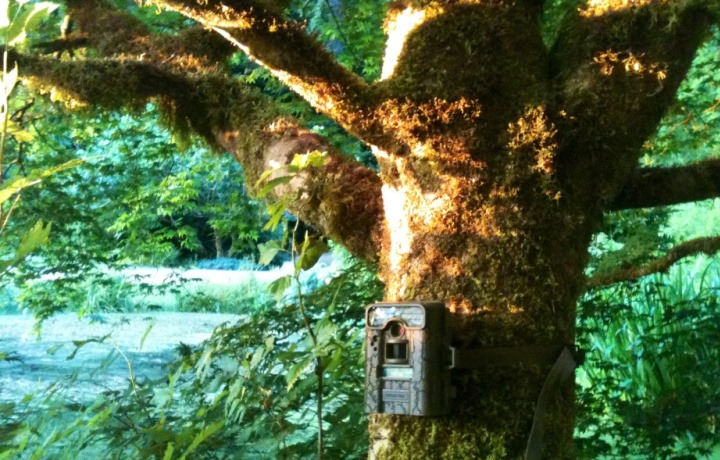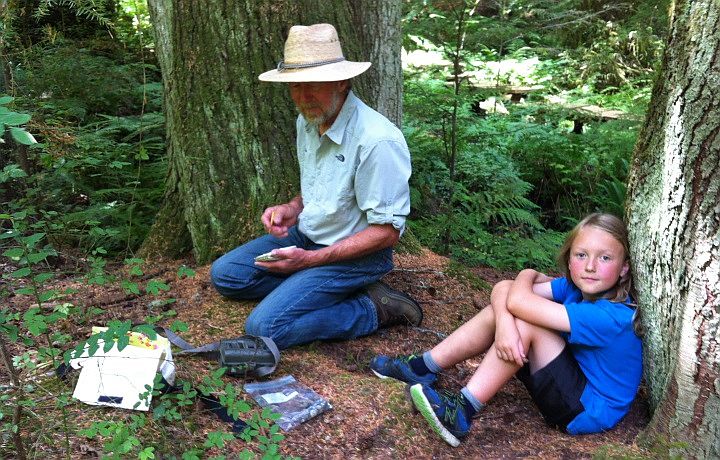With the relatively recent arrival of coyotes on the island Vashon Nature Center has initiated a research program that is attempting to answer several baseline questions about: 1) abundance; 2) distribution and behavior patterns; 3) activity space; and 4) food habits of island coyotes.
Methods:
- Camera traps: Following recognized research procedures for noninvasive surveys of carnivores, VNC scientists are establishing survey sites in areas of suspected coyote activity. At each of these sites wildlife camera traps are deployed to detect the presence or absence of coyotes. Photographs are digitally recorded and images analyzed for frequency of detection and unique, individual characteristics, such as, color pattern, size and stature, physical deformities, etc. that may lead to the identification of individual coyotes. This information will enable researchers to make inferences about frequency of visitation, activity space and use patterns and eventually population size. To date, one north end survey site has detected the presence of coyotes on ten occasions during the past thirteen weeks. Other survey sites are being explored and will be established in the near future.

VNC researchers are using wildlife cameras to measure presence or absence of coyotes, to identify individual island coyotes, and to learn about their behaviors, and frequency of occurrence. photo by: Renee Rutkowski
- Coyote Reporting Network: In response to the increase of coyote related reports to VNC a database was established in 2011 and has recently been expanded to include direct reports from island naturalists. VNC’s Coyote Reporting Network logs coyote sightings, vocalizations (howls, yips, yelps) and incidents along with relevant geographic information and anecdotal comments. These reports are used to map activity patterns and movement over the 37 square miles of island habitat.
- Scat survey: Food habits of island coyotes are being investigated by the collection and analysis of fecal deposits, aka scat. Biologists and students at the Slater Museum, University of Puget Sound, in cooperation with VNC, prepare and microscopically examine scat collected island wide.
Vashon Nature Center scientists rely on the help of citizen scientists to gather data on sightings, howls, and scat locations, through our coyote reporting network. Please report your sightings and observations here.
Results and Recent News:
READ OUR MOST RECENT RESEARCH SNAPSHOT AUG 2016
Preliminary information from the above mentioned sources suggest that coyotes have adapted well to the island becoming a small, established population living a nearly invisible life feeding upon small mammals and fruits; the largest part of their diet consisting of voles, moles, rats and mice.

Vashon Nature Center scientist John Rupp and volunteer collect samples of coyote scat at Vashon Nature Center’s 2014 Bioblitz wildlife inventory. photo by: Bianca Perla
Coyote numbers remain elusive but their presence has been recorded from every sector of Vashon and Maury islands suggesting that either the population is one group of wide ranging, fast moving individuals or possibly that two or more subgroups have established territories to the north and south of Vashon as well as Maury.
This section will be updated as our research programs continue.
Last update: 12/16/2014
Implications:
Information obtained through VNC research will assist islanders in developing strategies to live with our most recent wildlife arrivals. Research will also contribute to a wider scientific understanding of coyote habits, diets, and their potential ecosystem effects. Coyotes may bring benefits to the island environment, as top carnivores, helping to provide a balanced, healthy ecosystem.
